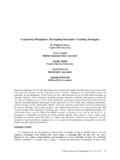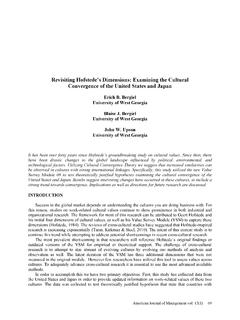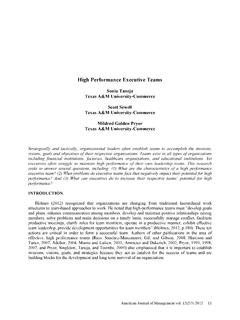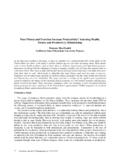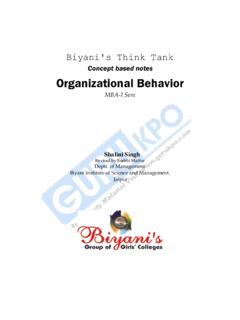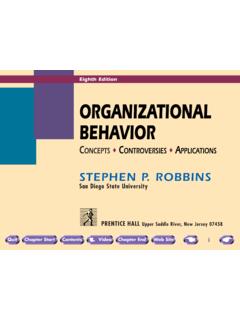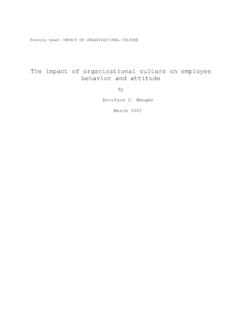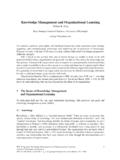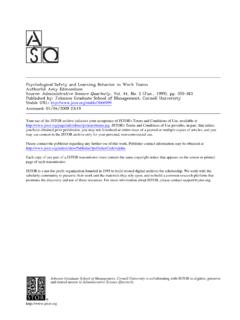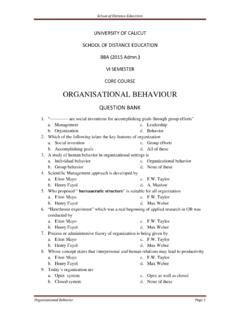Transcription of Organizational Behavior: A Study on Managers, Employees ...
1 Organizational behavior : A Study on Managers, Employees , and TeamsBelal A. Kaifi Saint Mary s College of California Selaiman A. Noori Carrington College California In recent decades, there has been a tremendous shift in the structure and operation of organizations. Advancements in technology and skill diversity have fostered a modern workplace of skill and workflow interdependencies. Hence, for success in today s business world, it is imperative for organizations to understand the forces that impact team outcomes. This Study on 100 managers from the same organ-ization shows that female managers have higher communication skills when compared to male managers, but are also more influenced by group think.
2 A total of 200 Employees from this organization were also studied and the results show that female Employees contribute to team outcomes more than male Employees . Implications for researchers, managers, and human resource professionals are considered. INTRODUCTION TO TEAMS In our modern world, teams are essential to everything individuals do in daily life. For many, their first exposure to the notion of teams began early on during participation in various youth sports. While playing a position on a team, whether on the soccer pitch or baseball diamond, young athletes are exposed to the timeless adage: There is no I in team.
3 Taking a quick look at the four letters that comprise this word and one can conclude that, indeed the letter I does not make an appearance. Approach this saying from a figurative perspective, and an entire world of interpretation is made possible. For instance, coaches will often teach their players that everyone on the team has a specific job to perform, and that every job is equal in its importance to overall team success. Through this lens, team work is seen as a tale of people with different skills coming together with a common purpose. Extending this concept to the context of the modern business world, we can note that there has been rapid Organizational movement from a collection of individual jobs to work groups and teams in response to emergent multilevel last two decades have experienced rapid advancements in technology and an unfolding of global forces that have pushed organizations worldwide to restructure work around teams to enable more rapid, flexible, and adaptive responses to the unexpected (Kozlowski & Ilgen, 2006, p.)
4 77). A number of forces are accelerating the shift in work structure. An increasingly stressful and emotionally taxing environment characterized by high competition, constant transformation, innovations in technology and best practices, and looming uncertainty generates many pressures for skill diversity, rapid response, and successful adaptation (Kaifi & Noori, 2010; Kozlowski & Ilgen, 2006). Teams offer the most effective approach to resolving the Organizational challenges of the Journal of Management Policy and Practice vol. 12(1) 2011 LITERATURE REVIEWO rganizational behavior (OB) is a field of Study devoted to recognizing, explaining, and eventually developing the attitudes and behaviors of people (individual and group) within organizations.
5 Organizational behavior is based on scientific knowledge and applied practice. According to Kaifi (2010), the RED Analysis can be applied by practitioners and researchers for understanding Organizational behavior issues:R- Recognize E- Explain D- DevelopDiagnosing Organizational behavior is an ongoing cycle of recognizingareas of concerns, explainingthe short-term and long-term implications of each behavior , and continuously developingbest practices and strategies that can help an organization transform into a robust, high-performing, and dynamic entity.
6 It must be mentioned that organizations need strong managers who are capable of controlling the organization s behavior . Managers who understand human resource management and strategic manage-ment are able to influence specific behaviors that help shape the culture of an organization. Influencing specific behaviors in an organization can be a difficult task to undertake for a number of reasons. The most obvious reason is that humans are unpredictable and have unique attitudes and perspectives. When they enter the workforce, they also bring their expectations and experiences to the workforce which many not correlate with the organization s mission.
7 This creates an instant dilemma that can be contagious to others. Controlling such Organizational ills is a battle with no end, which accurately explains whythe Study of Organizational behavior is so important. Being able to diagnose those issues and responding with well-formulated solutions is what many Organizational behavior researchers and managers strive for. The three primary outcomes of Organizational behavior are job performance, Organizational commitment, and quality of work life (QWL).Although Organizational behavior is an applied discipline, students are not trained in Organizational behavior .
8 Rather, they are educated in Organizational behavior and are a co-producer in learning (Nelson & Quick, 2011, p. 25). The Study of Organizational behavior requires a rudimentary understanding of psychology, anthropology, sociology, philosophy, and axiology. From a psychological perspective, human behaviors and mental processes dictate how organizations perform; from an anthropological perspective, the culture, language, and beliefs of each individual dictate how organizations perform; from a sociological perspective, the development of human and social behavior dictate how organizations function; from a philosophical perspective, the morals and ethics of an individual dictate how organizations function.
9 And from an axiological perspective, an individual s values dictate how organizations function. Other disciplines ( , economics, engineering, or social psychology) may be applied to Organizational behavior , as well. For example, in 1776, Adam Smith published The Wealth of Nationswhere he explained the economic advantages of division of labor (breakdown of jobs into narrow and repetitive tasks) in organizations. This diversity in Organizational behavior allows researchers to investigate new avenues for dealing with Organizational issues from different perspectives and Organizational behavior researchers believe that organizations are systems.
10 The two basic types of organization systems are closed and open. Many contemporary organizations are open systems that interact with their environment. A closed system does not depend on its environment and can function without the consumption of external resources. An open system must interact with the environment to survive by consuming and exporting resources to the environment. In an open and closed organization system, the peopleare the human resources of the organization who have specific skills, the purpose of the organization is the mission, vision, and goal for existing, the planof the organization is the strategy, competitive advantages, and objectives of the organization, and the prioritiesof the organization are what drive the organization to thrive or excel, which in most cases is revenue.

